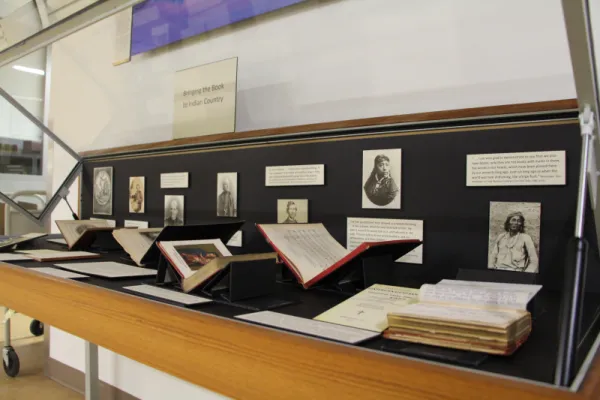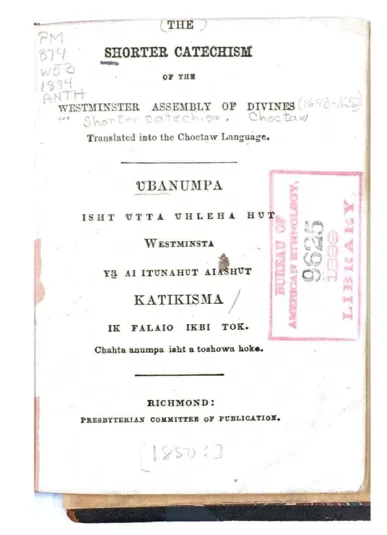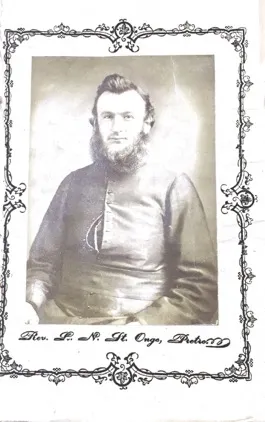
Search

News from Recovering Voices
The Native American Languages Early Publication Project
By: Cadence Thakur
12/17/2018

The Native American Languages Early Publication Project was created to promote awareness of and accessibility to the extensive historic collections of Christian literature that was translated into Native American languages in the 19th and early 20th century. These collections are now housed in the John Wesley Powell Library of Anthropology and the Joseph F. Cullman Library. Currently, this collection consists of Christian bibles or parts thereof, prayer books, hymnals, liturgies/catechisms, and religious school-books and dictionaries. In the future, there is hope that this project will expand to include other early publications in Native American languages. These two libraries are a part of a network of 21 specialized research libraries that make up Smithsonian Institution Libraries, focusing on science, art, history, culture, and museum studies. Located in the Natural History Museum, the Anthropology Library was established in 1965 through the merger of the libraries of the Bureau of American Ethnology and the department of Anthropology. Early and rare books of anthropology and natural history are also now housed in the Cullman library, which cares for thousands of titles published pre-1840, including approximately 200 volumes relevant to this project.
These two library collections have deep roots in the study of Native North American cultures, containing an enormous amount of information conducive to the revitalization of endangered languages. Primarily centered around the titles from North America and Mexico, this project was created by Gwyneira Isaac, director of Recovering Voices and Curator of North American Ethnology and Maggie Dittemore, head librarian for the Anthropology Library. As an intern at Breath of Life last year and a frequent volunteer at the Anthropology Library, I had previously spent a lot of time working with Gwyn and Maggie on this project and doing research on the respective histories of the works in these collections. The opportunity to be working with Native American languages once more and immersing myself in the unique combination of linguistics, history, and culture has been exciting.

A wealth of linguistic and historical knowledge of Native Americans, paradoxically, comes from the long-standing effort of Europeans to christianize indigenous peoples. Many missionaries were sent to live among Native American tribes and communities in the attempt to convert or teach them “improved” values. The development and translation of biblical literature in these Native languages was seen as a Housing 500+ titles in this vein, these two collections offer invaluable insight into this history along with useful language tools for reawakening languages. To begin, I made an inventory based off of the original list created by Ron Lindsey, librarian at the Anthropology Library, to obtain a more precise overview of the range of languages, tribes, and years which make up the collection. The database being constructed of the works at the Anthropology Library is cross-referenced with those in the Cullman library so researchers can view the full extent of the collections: I created a list of the collection in the Anthropology Library organized by call number, a list of the collection in the Cullman library organized by call number, a list of the collections in both libraries organized by date, and finally collected statistics about the languages in the collections the number of titles we have for each tribe. After completing this inventory, I prioritized the books based on the vitality of the languages within them using Ethnologue’s classification of endangered languages in the United States, UNESCO’s Interactive Atlas of the World’s Languages in danger and ELCat, the Catalogue of Endangered Languages.
The largest collection of titles in the Cree, Dakota, Ojibwe and Choctaw languages, whereas we have a smaller number of works among the most endangered languages, such as Arikara, Gros-Ventre, and Chinook. This classification enabled me to find a direction for my research, first and foremost attending to the history of individual volumes which could be the most useful and of most interest to tribes actively working to reawaken their language and to sustain those which are endangered. When an exact dialect was not specified in SIRIS–the current internal catalog database of the Smithsonian Libraries–or within the pages of the volume itself, the author, publisher, or location of publication were researched to pinpoint where the origins of the book and subsequently pair it with the correct dialect.
Another aspect of this classification relates to digitization. There are two factors which guide the digitization process relevant to this project: titles are prioritized based on the vitality of the concerned language as well as their pertinence to current language revitalization efforts. The next step is contacting tribes and exploring their level of interest in these collections, as well as facilitating access to the titles and their digital copies.
As part of public outreach nearly 200 of these volumes have been digitized and are now available to the public via the Internet. This is thanks to the considerable efforts of Katie Wagner, Jackie Chapman, Daniel Euphrat, Keri Thompson, and Stefaan Hurts (Pennsy scanning). Ron Lindsey created a detailed spreadsheet of the ca. 300 volumes to identify, track and evaluate/analyze this collection. The digitized volumes are also included in the Libraries online book collection titled “Early Publications in American Indian Languages.” We encourage you to take a look:

Early Native Languages Publication Outreach Project aims to increase awareness of and accessibility to the collections housed in the Anthropology and Cullman Rare Book libraries for community researchers, and ultimately contribute to ongoing revitalization efforts of indigenous languages across North America and Mexico.